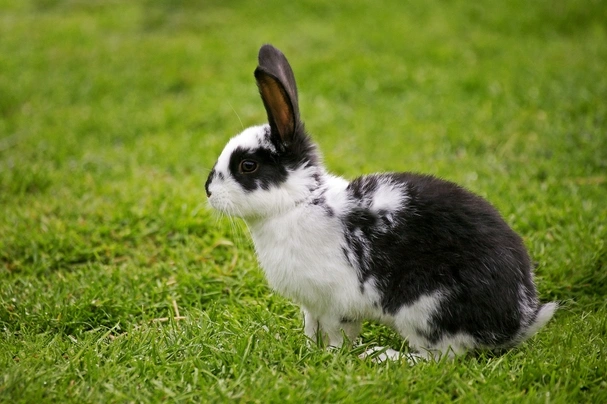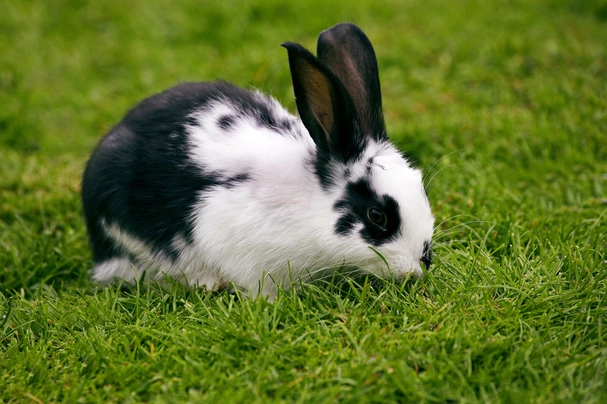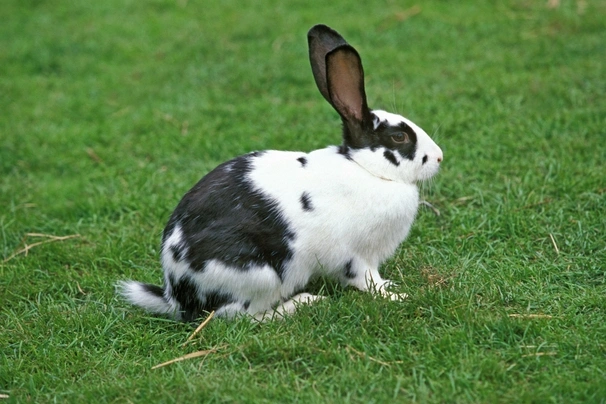Pets
Pets for studWanted petsBreedersAccessories & services
Knowledge hub
Support
Support & safety portalGiant Papillon
Introduction of the Giant Papillon
In the US this breed is known as the Checkered Giant, but in Europe, where the breed originated, it’s commonly referred to as the Giant Papillon. Fully grown adult males of the type should weigh around 11lbs, while adult does usually weigh a little more.
The Papillon is only outweighed by the Flemish Giant and the Giant Chinchilla and is considered first and foremost, a show animal, although they are popular as pets. In the US the Papillon – or Checkered Giant – is one of only 11 rabbit breeds that display defined patterns and markings and although markings differ between the European and American types, they are still considered to be the same breed.
History of the Giant Papillon
The Papillon was originally developed in the Lorraine region of north eastern France after breeders put together the Flemish Giant, spotted wild animals and the French Lop in the 19th Century. The breed was initially known as the Lorrainese. The results of the breeding programme were both spotted and the natural agouti colouring of wild rabbits. However, after many years of selective breeding the spotted ‘butterfly’ markings we see today began to appear and quickly became the favoured colourway for the Papillon.
The breed has been popular in Europe since it was first developed, but it found favour in America too, when it was exported there at the beginning of the 20th Century. It was there that different markings were preferred and developed and the Checkered Giant was born. Despite these differences in coat patterns however, the Papillon and the Checkered Giants are considered to be one in the same breed.
Appearance of the Giant Papillon
- Main colourways: White coat with blue, grey, chocolate, black, tri-colour or tortoiseshell markings
- Average weight: 5-6kg
The Papillon is one of the largest rabbit breeds, with fully gown bucks reaching 5kg (11lbs) and mature does tipping the scales at 6kg (13lbs). This rabbit has a muscular yet slender physique. The Papillon has a very straight, long back, with well-rounded hindquarters and powerful legs. The head is large and wide and the equally wide ears are held upright.
All Papillons have a white coat with markings in either grey, black, chocolate, blue, tortoiseshell or tri-colour. The ears are dark, as are the rings about the eyes, the cheek flashes and the butterfly marking on the nose. The flanks also display a scattering of spots either side of a herringbone which runs from the base of the neck to the tip of the tail. The fur is short, thick and very soft.
The breeding of good examples is not easy as many kits will display self-coloured coats or will be only partially marked. These partly marked animals are known as ‘Charlies’, a name which is thought to derive from the fact that the partially formed butterfly nose marking looks a little like a Charlie Chaplin moustache.
Temperament of the Giant Papillon
Most Papillons are friendly and easy going, however this is an energetic breed that loves to play and explore. They require lots of physical activity and will need lots of playtime and access to the outdoors either in a large run or a secure area of garden, where they can indulge their love of running and exploring.
As prey animals all rabbits can be nervous and need time, preferably when young, to get used to human company. Any owner must also learn how to handle a rabbit correctly. They need time and patience to allow them to trust and feel comfortable with people, but once they do they’ll feel happy playing and spending time with their family. Noisy cat and dog toys will be appreciated and if you spend time enjoying playtime with your rabbit, he’ll enjoy himself too.
It’s vital that all rabbits are handled properly. They can struggle if picked up – particularly if they feel uncomfortable or unsafe. The Papillon is a very strong animal and if it panics there’s a real risk of injury to both the rabbit and the handler. Spend time learning how pick up and carry a rabbit properly and only do it when absolutely necessary.
Health of the Giant Papillon
A lot of larger breeds can suffer with sore hocks. This condition is usually caused by wire flooring in their living quarters, which wears away the protective hairs covering the hock area. The skin on the hock is sensitive and can crack easily, leading to pain and discomfort – even infection. It’s wise to house a Papillon on a solid floor, or provide a resting board.
These animals can carry various STDs, although buying from a reputable breeder and only putting your animal to other quality breeding animals will help prevent these. Non-breeding does should be spayed in order to prevent uterine cancer, which is common in rabbits.
Any rabbit’s teeth should be checked regularly to prevent them overgrowing. All rodents’ teeth grow continually and overgrown molars and enamel spurs can cause oral injuries or difficulty eating. Any overgrown teeth should be trimmed by a vet. A diet high in roughage can also help keep the teeth worn down, so careful attention should be paid to his feeding regime.
He should not be overfed as overweight rabbits have difficulty grooming, which can make them vulnerable to flystrike. Any rabbit should also be treated regularly for fleas, ticks and worms and vaccinated annually for myxomatosis and Viral Haemorrhagic Disease.
Caring for the Giant Papillon
As a larger rabbit the Papillon is probably best kept in the house, where he’ll have enough room to stretch, stand up and hop around. He can be taught to use a litter tray, and as long as cables, wires, shoes and other important items are kept out of his way and he has a place where he can totally relax (a large dog crate would be perfect), then he’ll be happy indoors. Also, Papillons are known for not tolerating extremes of temperature, so being a house bunny will probably suit him best.
If he must be kept outdoors the hutch must provide at least five square feet of floorspace and enough height for him to stand on his hind legs. Any hutch should be completely weather and waterproof and fully insulated, with draft excluders fitted. It should be placed well out of direct sun or wind and if you have space in a well-lit, well-ventilated shed this would be ideal. The litter and bedding should be hardwood shavings and straw and it should be deep and plentiful enough for him to make a good nest. Most hutches come with a covered area where he can build his nest, get out of the weather and build his nest.
The hutch should be cleaned out each week, with droppings removed each day.
All rabbits should be fed a high-fibre, vegetarian diet comprising good hey, quality pellets and plenty of fibrous green leaves and vegetables such as dandelions, kale and cabbage. They should also have access to clean drinking water at all times.
Related adverts
See all


